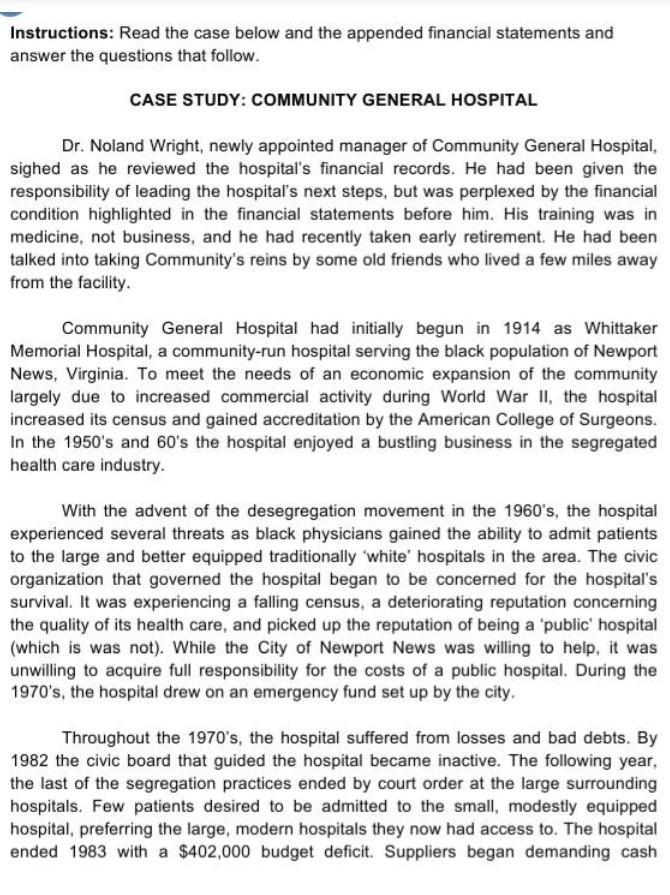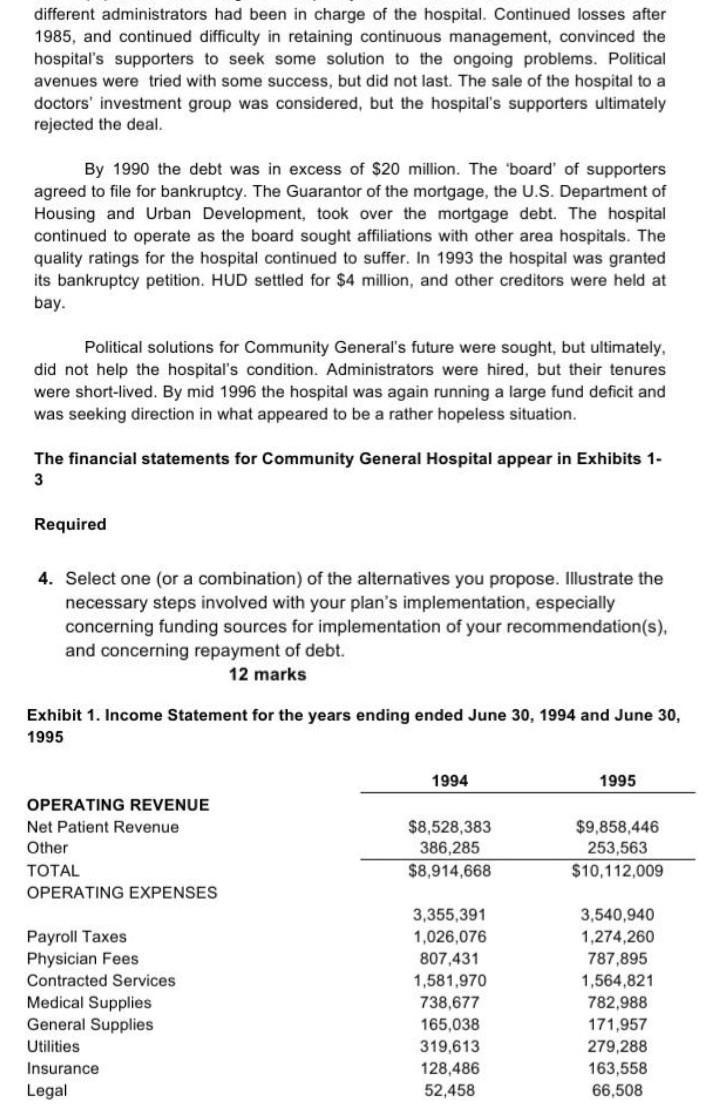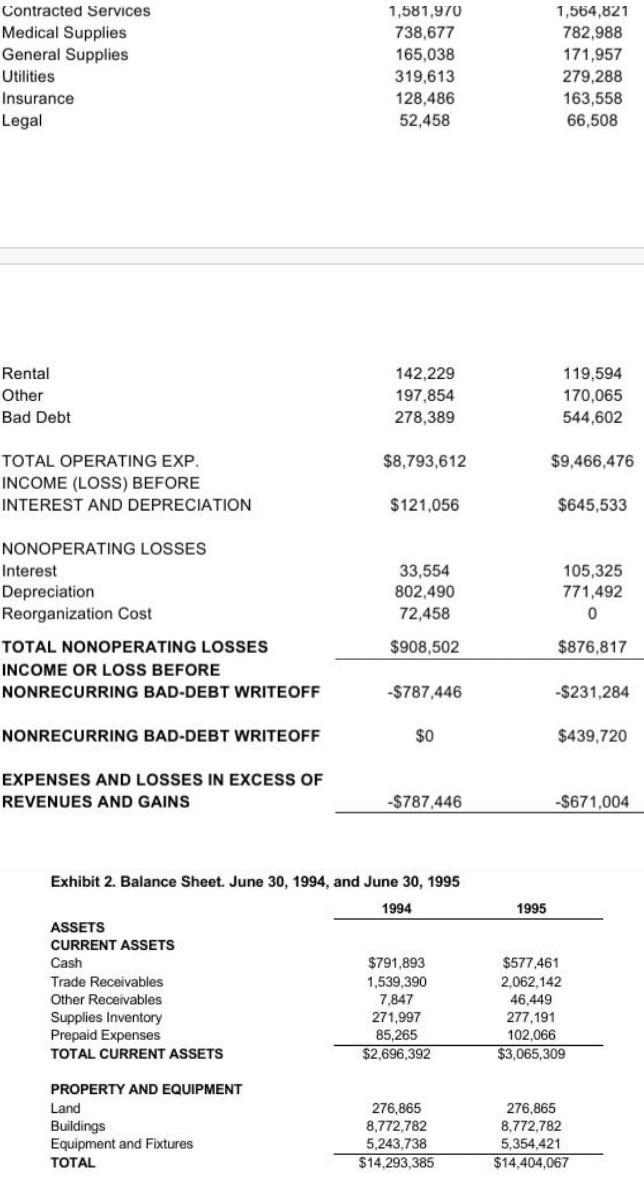Answered step by step
Verified Expert Solution
Question
1 Approved Answer
Instructions: Read the case below and the appended financial statements and answer the questions that follow. CASE STUDY: COMMUNITY GENERAL HOSPITAL Dr. Noland Wright,



Instructions: Read the case below and the appended financial statements and answer the questions that follow. CASE STUDY: COMMUNITY GENERAL HOSPITAL Dr. Noland Wright, newly appointed manager of Community General Hospital, sighed as he reviewed the hospital's financial records. He had been given the responsibility of leading the hospital's next steps, but was perplexed by the financial condition highlighted in the financial statements before him. His training was in medicine, not business, and he had recently taken early retirement. He had been talked into taking Community's reins by some old friends who lived a few miles away from the facility. Community General Hospital had initially begun in 1914 as Whittaker Memorial Hospital, a community-run hospital serving the black population of Newport News, Virginia. To meet the needs of an economic expansion of the community largely due to increased commercial activity during World War II, the hospital increased its census and gained accreditation by the American College of Surgeons. In the 1950's and 60's the hospital enjoyed a bustling business in the segregated health care industry. With the advent of the desegregation movement in the 1960's, the hospital experienced several threats as black physicians gained the ability to admit patients to the large and better equipped traditionally 'white' hospitals in the area. The civic organization that governed the hospital began to be concerned for the hospital's survival. It was experiencing a falling census, a deteriorating reputation concerning the quality of its health care, and picked up the reputation of being a 'public' hospital (which is was not). While the City of Newport News was willing to help, it was unwilling to acquire full responsibility for the costs of a public hospital. During the 1970's, the hospital drew on an emergency fund set up by the city. Throughout the 1970's, the hospital suffered from losses and bad debts. By 1982 the civic board that guided the hospital became inactive. The following year, the last of the segregation practices ended by court order at the large surrounding hospitals. Few patients desired to be admitted to the small, modestly equipped hospital, preferring the large, modern hospitals they now had access to. The hospital ended 1983 with a $402,000 budget deficit. Suppliers began demanding cash different administrators had been in charge of the hospital. Continued losses after 1985, and continued difficulty in retaining continuous management, convinced the hospital's supporters to seek some solution to the ongoing problems. Political avenues were tried with some success, but did not last. The sale of the hospital to a doctors' investment group was considered, but the hospital's supporters ultimately rejected the deal. By 1990 the debt was in excess of $20 million. The 'board' of supporters agreed to file for bankruptcy. The Guarantor of the mortgage, the U.S. Department of Housing and Urban Development, took over the mortgage debt. The hospital continued to operate as the board sought affiliations with other area hospitals. The quality ratings for the hospital continued to suffer. In 1993 the hospital was granted its bankruptcy petition. HUD settled for $4 million, and other creditors were held at bay. Political solutions for Community General's future were sought, but ultimately, did not help the hospital's condition. Administrators were hired, but their tenures were short-lived. By mid 1996 the hospital was again running a large fund deficit and was seeking direction in what appeared to be a rather hopeless situation. The financial statements for Community General Hospital appear in Exhibits 1- 3 Required 4. Select one (or a combination) of the alternatives you propose. Illustrate the necessary steps involved with your plan's implementation, especially concerning funding sources for implementation of your recommendation(s), and concerning repayment of debt. 12 marks Exhibit 1. Income Statement for the years ending ended June 30, 1994 and June 30, 1995 OPERATING REVENUE Net Patient Revenue Other TOTAL OPERATING EXPENSES Payroll Taxes Physician Fees Contracted Services Medical Supplies General Supplies Utilities Insurance Legal 1994 $8,528,383 386,285 $8,914,668 3,355,391 1,026,076 807,431 1,581,970 738,677 165,038 319,613 128,486 52,458 1995 $9,858,446 253,563 $10,112,009 3,540,940 1,274,260 787,895 1,564,821 782,988 171,957 279,288 163,558 66,508 Contracted Services Medical Supplies General Supplies Utilities Insurance Legal Rental Other Bad Debt TOTAL OPERATING EXP. INCOME (LOSS) BEFORE INTEREST AND DEPRECIATION NONOPERATING LOSSES Interest Depreciation Reorganization Cost TOTAL NONOPERATING LOSSES INCOME OR LOSS BEFORE NONRECURRING BAD-DEBT WRITEOFF NONRECURRING BAD-DEBT WRITEOFF EXPENSES AND LOSSES IN EXCESS OF REVENUES AND GAINS ASSETS CURRENT ASSETS Cash Trade Receivables Other Receivables Supplies Inventory Prepaid Expenses TOTAL CURRENT ASSETS 1,581,970 738,677 165,038 319,613 128,486 52,458 PROPERTY AND EQUIPMENT Land Buildings Equipment and Fixtures TOTAL 142,229 197,854 278,389 $8,793,612 $121,056 33,554 802,490 72,458 $908,502 Exhibit 2. Balance Sheet. June 30, 1994, and June 30, 1995 1994 -$787,446 $0 -$787,446 $791,893 1,539,390 7,847 271,997 85,265 $2,696,392 276,865 8,772,782 5,243,738 $14,293,385 1995 1,564,821 782,988 171,957 279,288 163,558 66,508 119,594 170,065 544,602 $9,466,476 $645,533 105,325 771,492 0 $876,817 -$231,284 $439,720 $577,461 2,062,142 -$671,004 46,449 277,191 102,066 $3,065,309 276,865 8,772,782 5.354.421 $14,404,067
Step by Step Solution
★★★★★
3.45 Rating (152 Votes )
There are 3 Steps involved in it
Step: 1
Community general hospitala profitability rrations show that the operat...
Get Instant Access to Expert-Tailored Solutions
See step-by-step solutions with expert insights and AI powered tools for academic success
Step: 2

Step: 3

Ace Your Homework with AI
Get the answers you need in no time with our AI-driven, step-by-step assistance
Get Started


